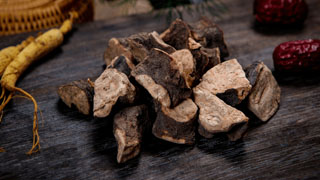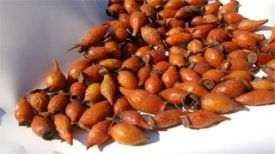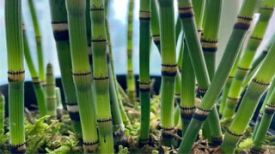
1. Aliases
Shou Wu, Chi Shou Wu, Ye Jiao Teng Gen, Sheng He Shou Wu, Di Jing, Chi Lian, Chen Zhi Bai, Hong Nei Xiao, Shan Ge, Shan Jing, He Xianggong.2. Plant morphology
Perennial entangled herbs. The roots are plump, with a reddish brown to dark brown appearance. The stem is multi branched, slightly woody in the lower part, thin in the upper part, sometimes pale red in color, with vertical stripes, and hollow. Leaves alternate, long stalked, ovate heart-shaped, apex gradually pointed, base heart-shaped or nearly heart-shaped, entire, both sides rough, hairless. Stipules sheath like, membranous, without cilia, often falling early. Inflorescence conical, terminal or axillary, spreading; Bracts ovate, central green, margin membranous transparent, hairless; 2-4 white small flowers are born inside the bracts, and the perianth is 5, varying in size. During fruiting, the outer ring is 3 enlarged and thickened, with broad wings on the back that extend down to the peduncle node; 8 stamens, shorter than perianth segments; 3 styles, with a head shaped stigma. Achenes triangular, black, glossy. The flowering period is in October, and the fruiting period is in November.
3. Origin distribution
Born at the foot of a mountain, by a stream, by the roadside, and in shrubs. Distributed in Guangdong, Guizhou, Guangxi, Henan, Jiangsu and other places.
4. Harvesting and processing
When the leaves wither in autumn and winter, dig them, cut off both ends, wash them, cut them into large pieces, and dry them.
5. Characteristics of medicinal herbs
Polygonum multiflorum appears in a clump or irregular spindle shape. The surface is reddish brown or reddish brown, with uneven wrinkles, shallow grooves, and transverse long skin pores and fine root marks. Weight, solid texture, not easily broken, with a light yellow brown or light reddish brown cross-section, appearing powdery. The skin has 4-11 circular irregular vascular bundles arranged in a cloud like pattern, with a larger central wood, some appearing as a wood core. Slightly qi, slightly bitter and sweet taste.
6. Nature, taste, and meridian tropism
Warm in nature, bitter, sweet, and astringent in taste. Guigan Meridian, Kidney Meridian, and Heart Meridian.
7. Effect and function
Detoxify, relieve carbuncle, moisten intestines and relieve constipation. Runxia medicine belongs to the category of laxatives.
8. Clinical applications
Dosage 6-12 grams, decoct and take. Used to treat scrofula, eczema, itching, intestinal dryness, constipation, and hyperlipidemia.
9. Pharmacological research
Polygonum multiflorum has the effects and effects of anti-aging, enhancing immunity, and promoting adrenal cortex. It can promote the newborn and development of blood cells, regulate blood lipids, fight atherosclerosis, and protect the liver. Anti atherosclerosis; Delaying aging; It can increase the coronary blood flow of isolated rabbit hearts and antagonize the slowing of heart rate caused by posterior pituitary hormone, but has no antagonistic effect on arrhythmia caused by posterior pituitary hormone; Antibacterial.
10. Chemical composition
Polygonum multiflorum contains anthraquinone compounds, among which emodin 8-0-B-D-glucoside is one of the active ingredients that promote intelligence in Polygonum multiflorum; The quinone component, 2,3,5,4-tetrahydroxystilbene-2-0-B-D-glucoside, has a wide range of cardiovascular activity, immune regulation, and hepatoprotective effects. Amide compounds include muping aristolomide, N-trans feruloyl-3-methyldopamine, etc; Chromogenic ketones include 7-hydroxy-2,5-dimethylchromogenic ketones, etc; Using stilbene glycoside as an active ingredient for anti-aging and lipid-lowering effects. The addition of 2,3,5,4-tetrahydroxystilbene-2-0- (6 "- O-a-D-glucopyranose) - B-D-glucoside has an inhibitory effect on the proliferation of vascular smooth muscle cells. In addition, it contains aloe emodin, emodin, anthraquinone, emodin, emodin methyl ether, rhein, and picroside.
11. Taboos for use
It is not suitable for those who have clear stools and wet phlegm, and iron utensils should be avoided.
12. Compatibility prescription
1. Treatment of malaria: 20 grams of Polygonum multiflorum, 2 grams of licorice, recommended for children. Take 1 dose daily, decoct for 2 hours, take 3 times before meals, and continue to use for 2 days. [Guangdong Medicine, Traditional Chinese Medicine Edition, 1964, (4): 31]
2. Treating body sores, swelling, itching, and pain: divide into equal parts for Fangfeng, Sophora flavescens, Polygonum multiflorum, and peppermint. The upper part is coarse powder, with 15 grams of medication, half water and half wine, sharing one dou and six liters. Boil it for ten times, wash it hot, and take a nap in a sheltered place. (Essentials of Surgery: Polygonum multiflorum powder)
3. Treatment of large intestine wind toxicity and persistent diarrhea: 60g of Polygonum multiflorum, pounded into powder. Before eating, drink 3 grams of warm Congee. (Shenghui Fang)
4. Treating excessive sweating: Polygonum multiflorum, Polygonum multiflorum powder, Jin Tiao, sealing the navel. ("Bianhu Ji Jian Fang")
5. Treatment of bleeding from wounds: Apply the end of Polygonum multiflorum to stop it. (Health Journal)
The content of the article is for clinical reference only. Non professionals in traditional Chinese medicine are not allowed to try medication.


